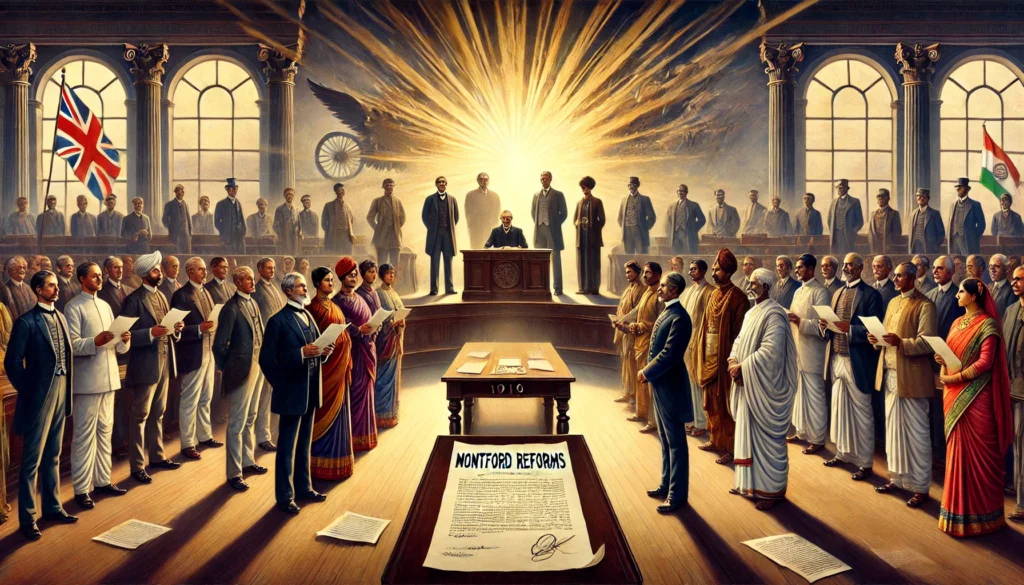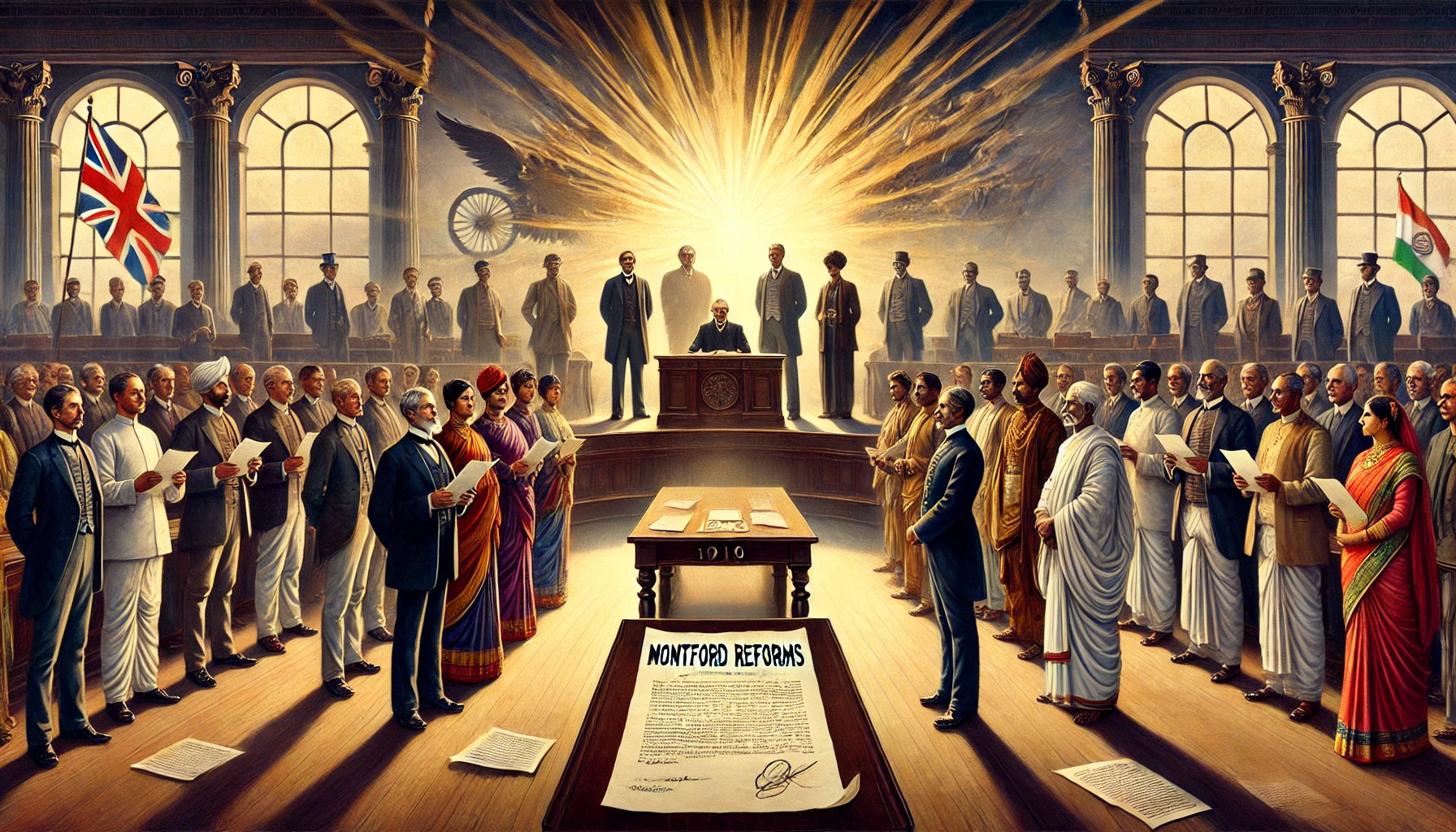The Montford Reforms: A Step Toward Freedom or a Symbol of Delay of 1919?
Introduction
Montford Reforms, technically known as the Government of India Act 1919 is an important milestone in the constitutional history of British India. Enacted by the Montagu-Chelmsford Commission, these reforms were enacted to redress the rising Indian needs for self-governance, yet maintaining British authority. This essay would explore the historical background giving rise to the reforms, their salient features, their effects on the Indian body polity, and their heritage in the struggle for independence.

Historical Background
These were, however, only the early years of the 20th century, and there was a total political awakening in India. Overarching social and economic discontent within the country combined with the intensity of the World War brought forth more acute demands for political reforms. Britain, in all its resources, was put through acute strain; this came not just at its front but at the back, with Indian soldiers as well as Indian civilians coming out in loyalty to it. The Montagu-Chelmsford Reforms were thus a response to these pressures. Pressure by the Indian National Congress and other organizations for greater autonomy led to the Montagu-Chelmsford Reforms.
The Montagu-Chelmsford Commission
In 1917, British Secretary of State for India Edwin Montagu and Viceroy of India Lord Chelmsford were entrusted with the task to appraise the political scenario in India. Their report was published in 1918, outlining big changes in the system of administration. The key objectives were self-government, more Indian involvement in politics, and more stable British rule in India.
Montford Reforms: Its Main Features :
The Montford Reforms were approved by the British Parliament in 1921 and implemented in 1921-22. It is considered a milestone in the constitutional history of India.
The Montford Reforms involved several crucial changes in the political sceneries of India:
Dyarchy in Provincial Governance
The most notable feature in the Montford Reforms was the introduction of dyarchy in the governance of provinces. The subjects were divided among the provinces as “transferred” and “reserved.”
Transferred Subjects: These comprised of the subjects such as education, health, and local government, to be administered by Indian ministers responsible to the legislative councils.
Protected Subjects: This included defense, foreign affairs and revenues which were still under the rule of the British official Governor. The framework only curbed the power of Indians and ensured British control over the central element of administration .
Expansion of Legislative Councils
The innovations involved an expansion of legislative councils at the center as well as in the provincial level.
The size of the central legislative council was now increased to 60 members, comprising partly elected and nominated members, under the Indian Council Act of 1919. In this, however, British appointments constituted the majority.
Provincial Legislatures: Provinces were provided with their legislative council, much more power than it had enjoyed previously. They, however, were given voting rights in the hands of only a minor portion of the population and, thus, became less representative.
Separate Electorates
The Montford Reforms maintained the system of separate electorates: for instance, Muslims, Sikhs, and Anglo-Indians. The provision was made explicitly with the idea of affording representation to these minority communities, but subsequently it heightened fissures in Indian society. Communals ruined national integration; it also encouraged sectarian politics.
Extension of a Limited Franchise
Although the reforms did expand the electorate, the franchise was limited. Only about 10% of the population could vote, mostly comprising those who had the required property qualifications. This exclusion meant that many Indians, mostly women and lower classes, were still not given a say in governance.
Impact on Indian Society
The Montford Reforms had mixed impact on Indian society.
Increased Political Consciousness
The movements brought about more political awareness among Indians. The legislative councils were established to provide Indian politicians with an opportunity to air their demands and grievances. Political parties including the Indian National Congress and the Muslim League began making strong campaigns for Indian demands.
New Leaders Emergence
Changes paved the way for new political leaders in India to come forth and play important roles for the Indian independence movement. Among such figures were Motilal Nehru, Annie Besant, and Jinnah. Their participation in the legislative process elevated them into higher planes as they endeavored to influence policy decisions.
Growing Disillusionment
The elements of self-governance that were introduced were not enough to spark any enthusiasm amongst Indians. The quantum of reforms also appeared meager. The system of dyarchy was often referred to as an imaginary unit of self-rule which did nothing whatever to divest or devolve any inch of ground from the British on matters of sovereignty. The British retained most areas in control and went on to provoke further anger and calls for more drastic measures.
Nationalism Emerges
The Montford Reforms inadvertently fed into nationalist sentiments. Britain’s sparsely handed concessions were considered insufficient and stimulated more pressure for complete independence. Movements for self-rule gained momentum, and such events as the Non-Cooperation Movement under the leadership of Mahatma Gandhi began in the 1920s.
Criticism of the Montford Reforms
The Montford Reforms was highly criticized as follows:
The scope of reforms was rather limited
Critics criticized the fact that reforms were incomplete from the center demand for self-governance. Continued British control over vital sphere of government negated the spirit of reform and the continuation of colonial rule.
Communal Politics
The system of separate electorates redefined the communal division but, at the same time, encouraged communal tensions amongst all religions. That system of separate electorates made it very awkward for a unitary nationalist movement and paved the way for all future communal conflicts.
Failure of Dyarchy
The dyarchy system was generally criticized as confusing and prone to conflict between the elected Indian ministers and the British governors. The system was also ineffective and frustrating because Indian ministers were not given much real power and had little authority.
Legacy of the Montford Reforms
The after effect of the Montford Reforms reached up to the movement and course of Indian politics and the struggle for independence:
Catalyst for Future Reforms
That provides the legislative ground for further developments in the constitution in the form of the Government of India Act 1935. The demand for more thoroughgoing reforms and total independence began to escalate with the inherent limitations of the 1919 reforms.
Foundation for Nationalist Movements
It was an empowerment process in the Montford Reforms, which advocated for nationalist movements. This brought sections of Indian society into the political mainstream and helped to form a unified front against colonialism.
Organisational Framework for Governance after Independence
Experiences and lessons learned from the Montford Reforms conditioned the framing of India’s Constitution after 1947. The same elements of representation, the rights of the minorities, and federalism could thus be followed back to that earlier time of constitutional experiment.
Conclusion:-
Thus, the Montford Reforms of 1919 formed an important but only partial step towards addressing the mounting demands for self-rule in India. Despite the reforms that brought in certain elements of political representation, it did not meet the long-awaited expectations of the Indian people. The disappointment and the desire for more self-rule brought the Indian independence movement forward in the sequence of Indian history. Montford Reforms remind one of the intricate aspects of colony management and the long ceaseless struggle for self-rule by colonized nations.
Also Read:- The Charter Act: A Bold Step Toward Justice and Reform

